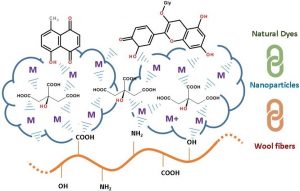Use of pomegranate peels and walnut green husks as the green antimicrobial agents to reduce the consumption of inorganic nanoparticles on wool yarns
Mousa Sadeghi-Kiakhani* Department of Organic Colorants, Institute for Color Science and Technology, PO Box 16765-654, Tehran, Iran
Ali Reza Tehrani-Bagha Department of Chemical and Petroleum Engineering, American University of Beirut, Beirut, Lebanon
Kamaladin Gharanjiga Center of Excellence for Color Science and Technology, Institute for Color Science and Technology, Tehran, Iran
Elahe Hashemi Department of Chemistry, Faculty of Science, Shahid Rajaee Teacher Training University, Tehran, Iran
*Corresponding author. E-mail address: sadeghi-mo@icrc.ac.ir (M. Sadeghi-Kiakhani)
For reducing the cost of production and saving the environment, the utilization of chemicals, energy, and processing time should be minimized as much as possible. In this study, antimicrobial finishing of wool fibers was achieved by synthesizing Ag/Cu2O/ZnO nanoparticles (NPs) in-situ on the surface of wool fibers, and subsequently dyeing with two natural dyes extracted from Pomegranate peels and Walnut Green husks.
The extracted natural dyes had also noticeable antimicrobial activities. This decreased the consumption of Ag/Cu2O/ZnO nanoparticles (NPs) for antimicrobial finishing of wool yarns. The wool samples were dyed at the initial dye concentration of 30% over weight of fiber (o.w.f.), at 100 degrees C, pH 5.0 for 60 min. The treated samples were characterized by Scanning Electron Microscope (SEM), X-ray diffraction (XRD) analysis, reflectance spectrophotometer, and electromechanical tensile tester. The presence of nanoparticles was confirmed on the surface of the samples by SEM micrographs and XRD profiles. The mechanical properties of the treated samples improved slightly (less than 2%). The antimicrobial activities of the samples treated only with Pomegranate peels and Walnut Green husks were 65% and 35%, respectively. The antimicrobial activity of the treated wool yarns with inorganic salts after the dyeing process was excellent (almost 100%). Moreover, the wash and light fastness properties of the treated samples were all very good to excellent. The dyed sample treated with Ag salt maintained its high antimicrobial activity (>91%) even after 10 repeated washing cycles. The light-fastness of the dyed samples was improved from moderate to very good after treatment with the inorganic salts. The proposed eco-friendly dyeing process can also improve the antimicrobial properties of wool yarns.
Conclusion
The results of this work can be summarized as follows:
- In-situ formation of inorganic NPs containing Ag, Cu, or Zn and their combinations improved the antimicrobial properties of the wool yarns. The treatment had a very good and acceptable fastness properties. The antimicrobial activity of the sample covered with Ag NPs and dyed with pomegranate and walnut dyes was still very good (above 91%) after 10 repeated washing cycles.
- The optimum conditions for dyeing wool yarns using pomegranate peels and walnut green peels were found to be at an initial dye concentration of 30% o.w.f., at pH 5, at
100 degrees C for 60 min. The washing fastness of the dyed samples (without prior pretreatment) was very good. The light-fastness of the dyed samples improved from moderate to very good after treatment with inorganic salts. - The color strength, fastness properties, and antimicrobial activities of the treated and dyed samples improved. This was attributed to the complex formation and coordination of organic dyes with the NPs on the surface of wool fibers. The most effective treatment was achieved with silver salts.
- Based on the results, it can be suggested that Pomegranate peels and Walnut Green peels can be used as natural colorants to increase the antimicrobial activity of wool yarns with or without using antimicrobial inorganic salts. Considering the human health hazards related to the application of toxic antibacterial compounds, dyeing with these natural dyes can be seen as a green approach. Wool dyeing with these natural dyes can reduce the amount of needed NPs for the treatment. This will be a greener and cheaper approach for dyeing and improving the antimicrobial properties of wool yarns.
Source: https://doi.org/10.1016/j.jclepro.2019.05.283
0959-6526/© 2019 Published by Elsevier Ltd. For full access, please contact the Publisher.

